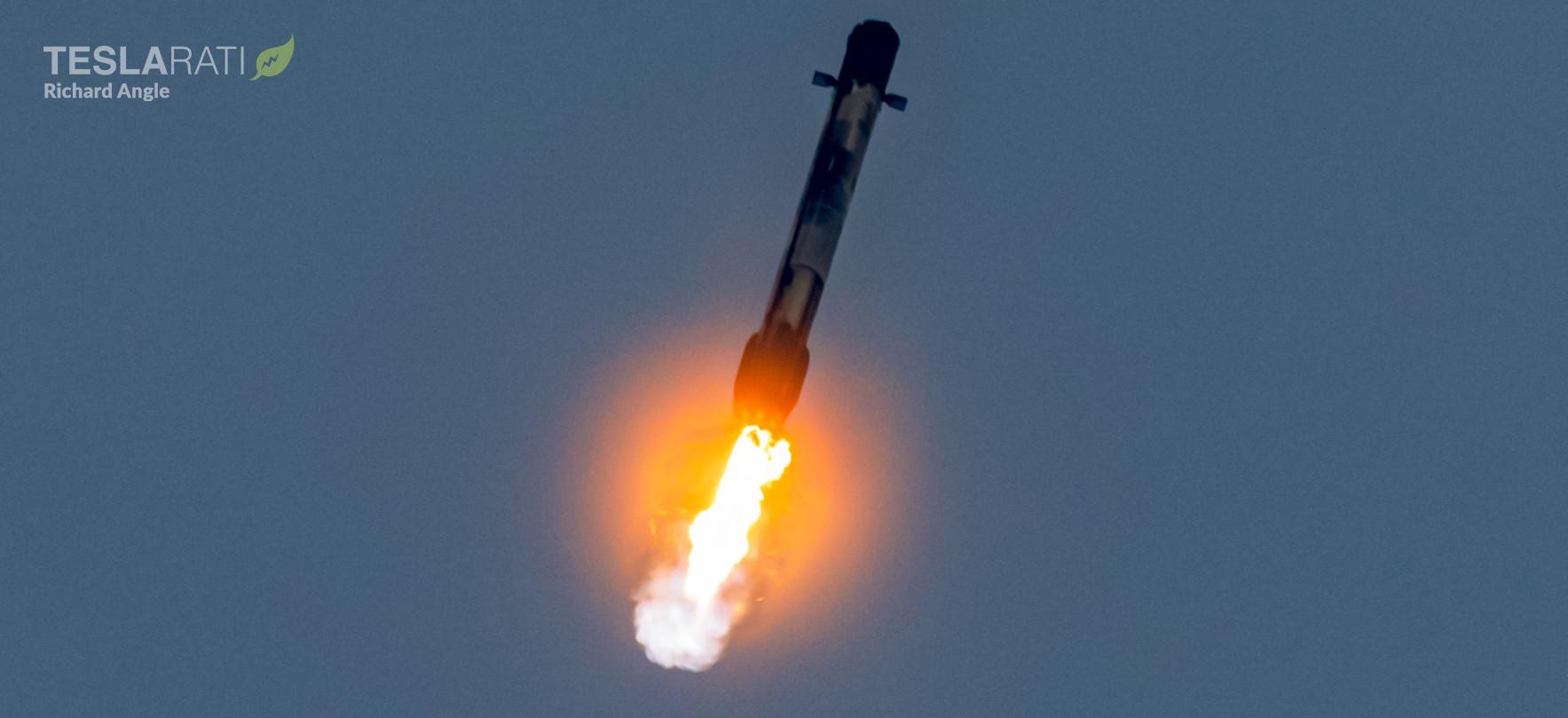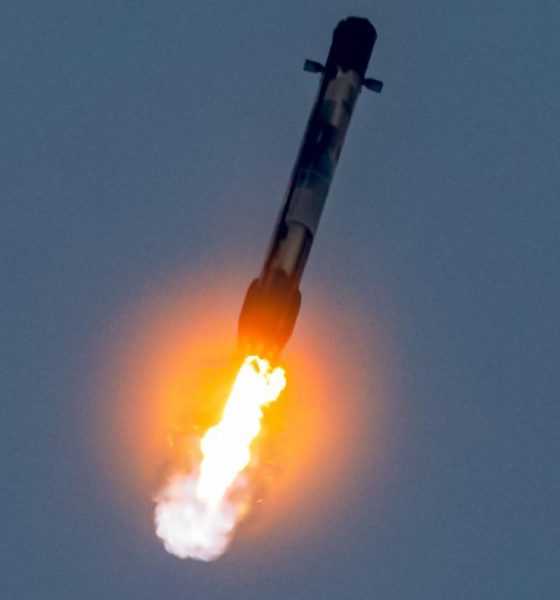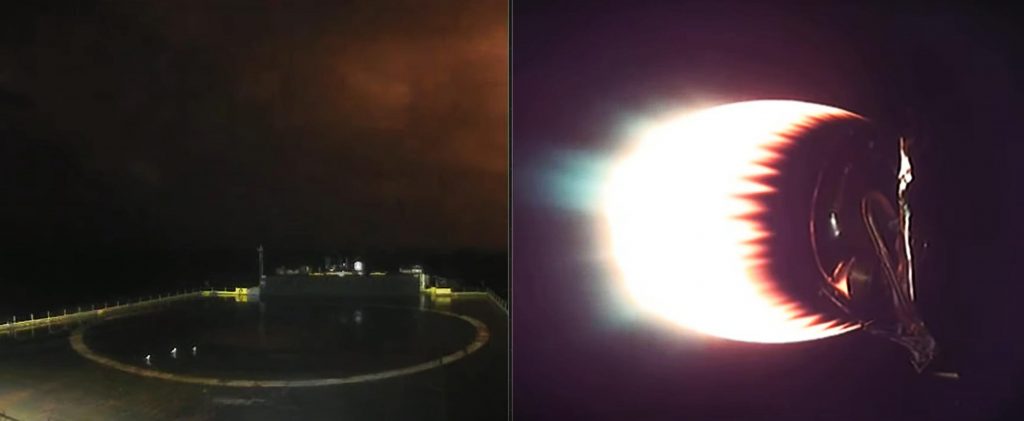

News
SpaceX rocket suffers rare landing failure after kicking off Starlink doubleheader
In a rare surprise for Starlink launches, a SpaceX Falcon 9 booster has failed to successfully land after kicking off the first of two Starlink missions planned in a 25-hour period.
Some nine minutes after liftoff, Falcon 9 booster B1059 suffered an unknown failure that cut short its sixth landing attempt a second or two after landing burn. With no sign of a sustained burn, the booster most likely impacted the ocean at supersonic or high-subsonic speeds, unfortunately ending a record streak of 24 consecutively successful Falcon landings.
Thankfully, Falcon 9 B1059 had already supported five orbital-class launches since its December 2019 debut and, as always, booster recovery is always a secondary objective for SpaceX launches. The primary objective, deploying another batch of 60 Starlink satellites, is on its way to completion as Falcon 9’s upper stage orbits the Earth in preparation for a second small burn and payload deployment around 65 minutes after liftoff.
Update: Falcon 9’s upper stage performed flawlessly, igniting for a brief one-second orbit-raising burn and ultimately deploying a batch of 60 Starlink satellites without issue.

Known as Starlink V1 L19 or Starlink-19, the February 15th mission will be SpaceX’s 19th Starlink launch since operational ‘v1.0’ satellites first began flying in November 2019 and the 20th Starlink launch overall. Earlier this month, SpaceX’s Starlink-18 launch pushed the vast satellite broadband constellation past the 1000-satellite mark, making it the first constellation in history to grow to four digits strong.
Starlink-19 continues that growth just days after SpaceX quietly opened Starlink internet signups to almost anyone on Earth. According to SpaceX, the company expects the growing Starlink constellation to offer connectivity almost anywhere on Earth by the end of 2021.
Starlink-19’s landing failure serves as a bittersweet reminder that SpaceX’s ambitions of a broadband constellation several thousand (to several tens of thousands of) satellites strong is almost intrinsically contingent upon routine, reliable booster reusability. If SpaceX lost boosters on even a small fraction of the one or several hundred Falcon 9 launches needed to launch that constellation, the cost of getting Starlink into orbit would likely balloon by a factor of 5-10, if not more.
Ultimately, SpaceX will almost certainly determine the root cause of Falcon 9 B1059’s landing failure and use any lessons learned – however painfully acquired – to benefit all future Falcon launches and landings. There is a limited chance that this could impact SpaceX’s upcoming Crew Dragon Crew-2 mission in April, which is scheduled to be the first crewed launch ever to use a privately-developed flight-proven booster, but any knowledge gained will ultimately make Falcon 9 a safer rocket in ways that no other existing launch provider can match.

Barring delays caused by B1059’s landing failure, Starlink-17 – delayed roughly ten times by weather and technical bugs over the last month – is scheduled to launch no earlier than 12:55 am EST (5:55 UTC) on Wednesday, February 17th, a few minutes less than 26 hours after Starlink-19. Stay tuned for SpaceX’s official webcast!

News
Tesla FSD fleet is nearing 7 billion total miles, including 2.5 billion city miles
As can be seen on Tesla’s official FSD webpage, vehicles equipped with the system have now navigated over 6.99 billion miles.

Tesla’s Full Self-Driving (Supervised) fleet is closing in on almost 7 billion total miles driven, as per data posted by the company on its official FSD webpage.
These figures hint at the massive scale of data fueling Tesla’s rapid FSD improvements, which have been quite notable as of late.
FSD mileage milestones
As can be seen on Tesla’s official FSD webpage, vehicles equipped with the system have now navigated over 6.99 billion miles. Tesla owner and avid FSD tester Whole Mars Catalog also shared a screenshot indicating that from the nearly 7 billion miles traveled by the FSD fleet, more than 2.5 billion miles were driven inside cities.
City miles are particularly valuable for complex urban scenarios like unprotected turns, pedestrian interactions, and traffic lights. This is also the difference-maker for FSD, as only complex solutions, such as Waymo’s self-driving taxis, operate similarly on inner-city streets. And even then, incidents such as the San Francisco blackouts have proven challenging for sensor-rich vehicles like Waymos.
Tesla’s data edge
Tesla has a number of advantages in the autonomous vehicle sector, one of which is the size of its fleet and the number of vehicles training FSD on real-world roads. Tesla’s nearly 7 billion FSD miles then allow the company to roll out updates that make its vehicles behave like they are being driven by experienced drivers, even if they are operating on their own.
So notable are Tesla’s improvements to FSD that NVIDIA Director of Robotics Jim Fan, after experiencing FSD v14, noted that the system is the first AI that passes what he described as a “Physical Turing Test.”
“Despite knowing exactly how robot learning works, I still find it magical watching the steering wheel turn by itself. First it feels surreal, next it becomes routine. Then, like the smartphone, taking it away actively hurts. This is how humanity gets rewired and glued to god-like technologies,” Fan wrote in a post on X.
News
Tesla starts showing how FSD will change lives in Europe
Local officials tested the system on narrow country roads and were impressed by FSD’s smooth, human-like driving, with some calling the service a game-changer for everyday life in areas that are far from urban centers.

Tesla has launched Europe’s first public shuttle service using Full Self-Driving (Supervised) in the rural Eifelkreis Bitburg-Prüm region of Germany, demonstrating how the technology can restore independence and mobility for people who struggle with limited transport options.
Local officials tested the system on narrow country roads and were impressed by FSD’s smooth, human-like driving, with some calling the service a game-changer for everyday life in areas that are far from urban centers.
Officials see real impact on rural residents
Arzfeld Mayor Johannes Kuhl and District Administrator Andreas Kruppert personally tested the Tesla shuttle service. This allowed them to see just how well FSD navigated winding lanes and rural roads confidently. Kruppert said, “Autonomous driving sounds like science fiction to many, but we simply see here that it works totally well in rural regions too.” Kuhl, for his part, also noted that FSD “feels like a very experienced driver.”
The pilot complements the area’s “Citizen Bus” program, which provides on-demand rides for elderly residents who can no longer drive themselves. Tesla Europe shared a video of a demonstration of the service, highlighting how FSD gives people their freedom back, even in places where public transport is not as prevalent.
What the Ministry for Economic Affairs and Transport says
Rhineland-Palatinate’s Minister Daniela Schmitt supported the project, praising the collaboration that made this “first of its kind in Europe” possible. As per the ministry, the rural rollout for the service shows FSD’s potential beyond major cities, and it delivers tangible benefits like grocery runs, doctor visits, and social connections for isolated residents.
“Reliable and flexible mobility is especially vital in rural areas. With the launch of a shuttle service using self-driving vehicles (FSD supervised) by Tesla in the Eifelkreis Bitburg-Prüm, an innovative pilot project is now getting underway that complements local community bus services. It is the first project of its kind in Europe.
“The result is a real gain for rural mobility: greater accessibility, more flexibility and tangible benefits for everyday life. A strong signal for innovation, cooperation and future-oriented mobility beyond urban centers,” the ministry wrote in a LinkedIn post.
News
Tesla China quietly posts Robotaxi-related job listing
Tesla China is currently seeking a Low Voltage Electrical Engineer to work on circuit board design for the company’s autonomous vehicles.

Tesla has posted a new job listing in Shanghai explicitly tied to its Robotaxi program, fueling speculation that the company is preparing to launch its dedicated autonomous ride-hailing service in China.
As noted in the listing, Tesla China is currently seeking a Low Voltage Electrical Engineer to work on circuit board design for the company’s autonomous vehicles.
Robotaxi-specific role
The listing, which was shared on social media platform X by industry watcher @tslaming, suggested that Tesla China is looking to fill the role urgently. The job listing itself specifically mentions that the person hired for the role will be working on the Low Voltage Hardware team, which would design the circuit boards that would serve as the nervous system of the Robotaxi.
Key tasks for the role, as indicated in the job listing, include collaboration with PCB layout, firmware, mechanical, program management, and validation teams, among other responsibilities. The role is based in Shanghai.
China Robotaxi launch
China represents a massive potential market for robotaxis, with its dense urban centers and supportive policies in select cities. Tesla has limited permission to roll out FSD in the country, though despite this, its vehicles have been hailed as among the best in the market when it comes to autonomous features. So far, at least, it appears that China supports Tesla’s FSD and Robotaxi rollout.
This was hinted at in November, when Tesla brought the Cybercab to the 8th China International Import Expo (CIIE) in Shanghai, marking the first time that the autonomous two-seater was brought to the Asia-Pacific region. The vehicle, despite not having a release date in China, received a significant amount of interest among the event’s attendees.








